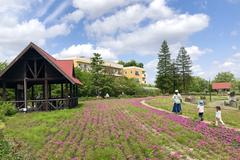Comprehensive Guide to Visiting Aoi Park, Handa, Japan
Date: 23/07/2024
Introduction
Nestled in the heart of Handa, Japan, Aoi Park is a captivating blend of historical significance, natural beauty, and cultural heritage. Boasting origins that trace back to the Edo period (1603-1868), this park has evolved from samurai estates to a modern public space that offers a tranquil retreat for visitors. Not only does it serve as a green oasis, but it also stands as a testament to Japan’s rich cultural tapestry. Whether you are drawn to its cherry blossom trees, historical monuments, or vibrant cultural events like the annual Handa Dashi Festival, Aoi Park provides a multifaceted experience that is both educational and rejuvenating. This guide aims to provide comprehensive information about Aoi Park’s history, cultural significance, and practical tips for making the most of your visit (Handa City).
Table of Contents
- Introduction
- Origins and Early Development
- Meiji Restoration and Modernization
- Establishment as a Public Park
- World War II and Post-War Reconstruction
- Cultural Significance and Preservation
- Recent Developments and Future Plans
- Notable Historical Events
- Architectural and Natural Features
- Visitor Information
- FAQ
- Conclusion
Aoi Park - History, Visiting Hours, Tickets, and Cultural Significance in Handa
Origins and Early Development
Aoi Park’s origins can be traced back to the Edo period when the area was part of a larger estate owned by a prominent samurai family. Initially used for agricultural purposes, including rice paddies and tea plantations, the land began to transform with the Meiji Restoration of 1868.
Meiji Restoration and Modernization
The Meiji Restoration marked Japan’s rapid modernization and industrialization. During this period, samurai estates were dismantled, and land was redistributed. New agricultural techniques and infrastructure were introduced, setting the foundation for Aoi Park’s future development.
Establishment as a Public Park
Influenced by Western urban planning, Japan began establishing public parks in the late 19th and early 20th centuries. In 1924, Aoi Park was officially established, designed to provide green space for Handa residents and preserve the area’s natural beauty.
World War II and Post-War Reconstruction
World War II impacted Handa significantly, and Aoi Park suffered damage. Post-war reconstruction efforts focused on creating public spaces symbolizing peace and recovery. The park was expanded and renovated to accommodate the growing population.
Cultural Significance and Preservation
Aoi Park is a vital cultural and historical site in Handa. It houses several monuments and statues, including a statue of Tokugawa Ieyasu, the founder of the Tokugawa shogunate. The park hosts various cultural events, such as traditional tea ceremonies and the annual Handa Dashi Festival, helping to preserve Japanese culture and traditions (Handa City).
Recent Developments and Future Plans
Recent improvements include new playgrounds, modern lighting, and enhanced landscaping. Future plans aim to develop Aoi Park as a center for environmental education and sustainability with eco-friendly facilities and conservation programs.
Notable Historical Events
The annual Handa Dashi Festival, featuring elaborate floats and traditional performances, is a significant cultural event hosted at Aoi Park. The planting of the Aoi Tree in 1947 symbolizes peace and unity, making it a beloved park landmark.
Architectural and Natural Features
Aoi Park’s design incorporates traditional Japanese garden elements, such as koi ponds, stone lanterns, and meticulously maintained flower beds. The park also features historical buildings like a traditional tea house and a small shrine.
Visitor Information
Visiting Hours and Tickets
Aoi Park is open daily from 9:00 AM to 5:00 PM. Admission is free, but some special events and guided tours may require tickets. For the latest information, check the official Handa City website.
Travel Tips
The best time to visit is during spring for cherry blossoms or autumn for stunning foliage. Guided tours provide valuable insights into the park’s history and cultural significance. Participating in cultural events or festivals can enhance your experience.
Nearby Attractions
Nearby attractions include the Handa Red Brick Building, the Niimi Nankichi Memorial Museum, and the Mizkan Museum, offering additional insights into the region’s rich history and culture.
FAQ
What are the visiting hours for Aoi Park? Aoi Park is open daily from 9:00 AM to 5:00 PM.
How much are tickets to Aoi Park? Admission to Aoi Park is free, but some special events and guided tours may require tickets. Check the official Handa City website for the latest information.
Are there guided tours available? Yes, guided tours provide valuable insights into the park’s history and cultural significance.
What are some nearby attractions? Nearby attractions include the Handa Red Brick Building, the Niimi Nankichi Memorial Museum, and the Mizkan Museum.
Conclusion
Aoi Park is a gem in Handa, offering a blend of historical significance, natural beauty, and cultural richness. Whether you’re interested in its storied past, serene landscapes, or vibrant cultural events, Aoi Park has something for everyone. Plan your visit today and experience the unique charm of this historical park. For more information, visit the Handa City website.
References
- Aoi Park - History, Visiting Hours, Tickets, and Cultural Significance in Handa, 2024, Researcher https://www.city.handa.lg.jp/
- Aoi Park - Visitor Information, Historical Significance, and Seasonal Attractions in Handa, 2024, Researcher https://www.handa-kankou.com/



